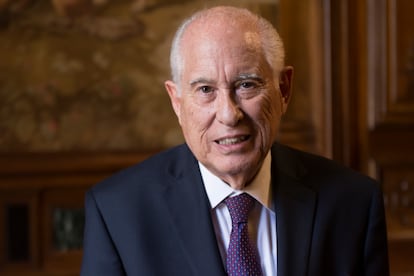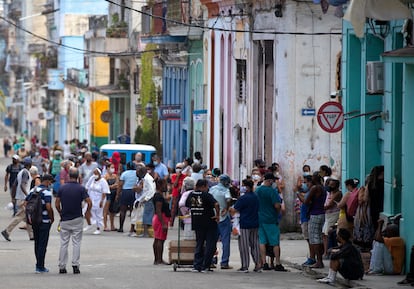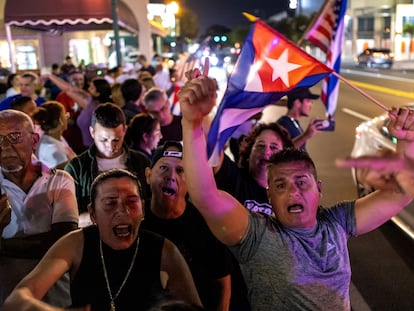Carmelo Mesa-Lago: ‘Today’s Cuba is a catastrophe’
On the verge of turning 90, the Cuban economist analyzes with data why this is the worst crisis the island has ever faced and reflects on the apparent arrival of capitalism to the last communist bastion of the West


On the verge of turning 90, as he publishes what appears to be his last book, renowned Cuban economist Carmelo Mesa-Lago has promised his wife Elena and his two daughters that he will stop writing. He has made that promise before but was not able to keep it. “I stopped writing for a month and I thought I was going crazy,” he says from his apartment in Pittsburgh, a city where he loves everything except winter, and where he is an emeritus professor at the University of Pittsburgh.
In 1961, at the age of 23, he left Cuba for Spain. He then settled in the United States. Mesa-Lago, a lover of cinema and travel, is a member of the U.S. National Academy of Social Security, the Latin American Academy of Sciences (ACAL), a professor at several universities around the world, and the author of dozens of books. He has also witnessed all the historical, economic and social events in Cuba since the triumph of the Cuban Revolution until today.
Question. What do you consider to have been Cuba's worst and best moments, economically speaking?
Answer. The worst time is now. There are some ways in which the crisis of the 1990s was worse, but, overall, this crisis has surpassed it. And the best moment was in the 1980s, particularly in the first half, when the Soviet Union (USSR) was subsidizing the Cuban economy. I have calculated that the USSR gave Cuba $65 billion between 1960 and 1990. Of that aid, two-thirds were price subsidies. The USSR paid the country seven times the world market price of sugar. It bought nickel at 50% above the world market price, and sold oil below the established price. It was a huge transfer of resources, and when the USSR fell the blow was brutal.
Q. What differentiates this crisis from others? Why do you say that this one is worse?
A. I have several reasons why I say that this crisis is worse: the first is that the crisis of the 1990s was preceded by a period that was the best. Cuba was at a much higher level than the one preceding this crisis. I have calculated Cuba’s average growth or decrease between 2019 and 2023, using government figures, and as an annual average it fell by almost 2%.
The second reason is related to what we call the gross rate of capital accumulation. In 1989, the rate fell 25% and the last year for which we have figures it was 16%. The industrial production index is also important. The drop in 2022 was 54%, meaning industrial production in 2022 was less than half of what it was in 1989. Regarding agriculture, I have calculated that between 2016 and 2022, there was an annual drop of agricultural production of 7.3%. In the 1990s, it didn’t go down like that.
And I think the worst of all is inflation, there is no comparison to it. If you look at all the years of that crisis, the worst were 1992 and 1993. Now, according to government figures, we are talking about inflation of almost 1000% in the year 2022. All the estimates made by foreign economists place inflation at three digits, 700%, 500%, so it is the worst inflation there has ever been. Outside of Venezuela, the worst inflation in Latin America is in Cuba, and it is among the highest in the world.
Q. I was born in the 1990s. I have never lived in a Cuba free of crisis. All that I have experienced is what we are seeing. Is there any period after the fall of the USSR when Cuba was doing well?
A. No, it has not been good, but it has been better. Starting at the beginning of the 21st century, [Venezuelan president Hugo] Chávez begins to supply oil to Cuba, finishes the Cienfuegos refinery, sends crude oil to Cuba to be refined, a part of that oil is returned to Venezuela, but he leaves the country another part to sell on the world market. It is the same thing that the USSR did. There is a huge investment from Venezuela, in a whole series of projects, and there is also a hidden subsidy, because it is an exchange of oil for doctors. The salary of a Cuban doctor is seven times the average salary of a Venezuelan doctor. In the case of the USSR, the subsidy was based on the price of imports. Here there is a subsidy because the value of the health professionals that Cuba sends is overestimated. That helped, but the economic levels that the country had before were never recovered. At the beginning of 2006 and 2007, Cuba had a fairly high growth rate. Then, between 2009 and 2013, there was a decline and the economy stagnated. It begins to drop again in 2019 and has continued to fall until today.
Q. What was the turning point in 2019?
A. The Cuban government blames it on the embargo. [U.S. president Donald] Trump takes power in 2016, and Cuba says: well, this is because of Trump. The far right says it is due to communism, and I think that is a very simplified answer. There is a combination of factors, but I think the most important is the economic system. Keep in mind that Raúl Castro’s reforms stalled around 2016.
For me, one of the fundamental causes, which has been consistent throughout the Cuban Revolution, is that Cuba does not generate enough exports to pay for imports. This leads to a trade deficit of goods. This deficit must be paid in some way, and it is paid for with dependence on another nation. First the Soviet Union, then Venezuela. And that makes the economic system unsustainable. When the protective or subsidizing partner loses, there comes a crisis. There is a crisis in the 1990s because the USSR disappears, and in the case of Venezuela, because of the humanitarian, economic, political and social crisis, and although aid from that country continues; today it sends half of the oil it sent before.

Q. You referred to the economic reforms under the mandate of [Cuban president] Raúl Castro. Some people believe that, in recent times, that was one of Cuba’s best stages. Why turn back?
A. My opinion is that Raúl never had the power of Fidel [Castro]. Fidel dominated all sectors, Raúl had to be more measured because there was an orthodox sector that was against the reform. Then Raúl passed a reform and that other group tried to sabotage it. I think their measures were well targeted, but they were very slow, they were loaded with obstacles, high taxes, inspections. They should have been faster and deeper. That is more important than what [Cuban President] Miguel Díaz-Canel has done: the only thing he has done is to legalize private companies.
Q. Regarding the government’s decision to open the private sector in order to bolster the economy, do you think they will reverse this move as they have done with other measures that involve private property?
A. What you say is true. Fidel, during the crisis of the 1990s, introduced a whole series of reforms, including opening up to self-employment, but he also introduced peasant markets, the dollar, allowed families to send remittances and developed tourism. That is what causes the decline to stop in 1994 and starts a partial recovery, because Cuba never returns to the levels of 1989. Fidel made these reforms reluctantly, he was never in favor of them, he did it to save the situation. Then comes Chávez’s help and everything is annulled, except tourism, which continues because it is an important force that does not affect the state’s control, since it is fundamentally controlled by the state. Later, with Raúl’s reforms, the same thing happened. In the case of Cuba, there is always the possibility of going back, unless the situation is very desperate.
Q. There is a lot of controversy around small and medium-sized enterprises (SMEs). For example, Aleida Guevara, the daughter of Che Guevara, has warned of the danger of the private sector. And, from Miami, politicians like Maria Elvira Salazar say that the private sector is a myth. Is it accurate to speak once again of the arrival of capitalism in Cuba?
A. The Communist Party says that the private sector is the Trojan horse that imperialism uses to try to destroy the Revolution. The New York Times published an article in which it exaggerated, and I will give you two or three examples. They say that 10,200 new jobs in the private sector have been opened up since 2021, when SMEs began to be approved, and they say that in 2023, between the private sector and the government, imports of each totaled $1 billion. I went to the Cuban statistical yearbook, and looked at the imports of the previous year, 2022, and they were $2.17 billion. In other words, what they are quoting for 2023 is 8% less than the previous year. It is not an increase, it is a decrease in imports. Not only in terms of volume, money, amount, but these imports buy less due to the problem of rising food prices. That is a distortion of reality. That figure was given by the government, but the government does not say that they were less than the previous year.
If you compare 2023 with 2013, the drop was 62%. That is, the value of imports in 2023 is 62% below that of 2013. And, if you compare it with 1989, the drop is 67%. This means that, despite SMEs, imports are reduced not only in amount, but in purchasing power. You’re giving me that as a demonstration of something successful, but, according to the numbers, it’s quite the opposite. They also say that the private sector provides half of the total employment, that is not true. Using 2023 figures, it is a third of total employment.
Q. There is a rise of SMEs in Cuba at the same time as there are protests over the lack of food. Do you feel that social classes are becoming more and more marked in the country, where it was always claimed that they didn’t exist?
A. Definitely. You have two classes in Cuba: one that receives remittances, but 60%, according to official figures, do not receive remittances. There is a population that can buy at outrageous prices. Then there are those who work for the state, for a miserable salary. If someone is involved with SMEs or receives money from abroad, they are fine, they can buy [food]. The others are starving. That egalitarian society is over, but the government does not speak of that.
Q. The Cuban government has always boasted of the “achievements of the Revolution”: health, education, social equality.... What remains of those symbols today?
A. I believe that the social development of Cuba was greater than its economic development, and that is a problem in terms of financing. If you don’t have subsidies, you can’t function. Indicators in the 1990s placed Cuba in first place in terms of equality, health, pensions, but never in housing. The Cuba of today has nothing to do with the Cuba of the 1980s, today’s Cuba is a catastrophe. The Revolution took steps to expand education, health and pensions, especially in the rural sector, but that no longer has anything to do with what we are experiencing today. For me, it is a tragedy. When Fidel Castro died, the first thing that came to mind was: how sad that this man who did these things and who could have done many others opted for a system that has failed all over the world and has destroyed the country. Because whatever you look at, housing, health, education, everything is finished.
Q. Amid the current crisis, the government dismissed the economy minister and announced a package of economic changes for the new year, which it later paused... What do you think is the path forward for Cuba?
A. It is more difficult for them to adopt a Swedish model, with democracy, than the Chinese-Vietnamese model of market socialism because it does not imply any political problem. I spent three years researching to write my book. What surprised me is that, in terms of social protection, China and Vietnam are above Cuba, two countries that were among the most underdeveloped in the world. In China, there was famine, millions of people died, and China is now almost self-sufficient in food. Vietnam is not only self-sufficient, but it generates a net for export, it is the second-largest rice exporter in the world. So that model would mean a substantial reform. If Raúl Castro’s reforms had not been hindered, and had advanced more quickly, perhaps it would have come to that.
Q. Why do you think the government has not taken that path?
A. The Orthodox sector in Cuba is very powerful, and there is the [Cuban state-owned] Business Administration Group, SA (Gaesa), which does not want to break its monopoly. If you change the plan and put in place a decentralized one, and decisions are not made from above, but come down and are made by businessmen, the private sector, and there is an important role for the market, the delegation of economic power implies a certain delegation of political power. There is a fear in that group that, if reforms are started, there will be a classic unstoppable snowball effect. I cannot prove that, but that is the only reasonable explanation I can find.
Sign up for our weekly newsletter to get more English-language news coverage from EL PAÍS USA Edition
Tu suscripción se está usando en otro dispositivo
¿Quieres añadir otro usuario a tu suscripción?
Si continúas leyendo en este dispositivo, no se podrá leer en el otro.
FlechaTu suscripción se está usando en otro dispositivo y solo puedes acceder a EL PAÍS desde un dispositivo a la vez.
Si quieres compartir tu cuenta, cambia tu suscripción a la modalidad Premium, así podrás añadir otro usuario. Cada uno accederá con su propia cuenta de email, lo que os permitirá personalizar vuestra experiencia en EL PAÍS.
¿Tienes una suscripción de empresa? Accede aquí para contratar más cuentas.
En el caso de no saber quién está usando tu cuenta, te recomendamos cambiar tu contraseña aquí.
Si decides continuar compartiendo tu cuenta, este mensaje se mostrará en tu dispositivo y en el de la otra persona que está usando tu cuenta de forma indefinida, afectando a tu experiencia de lectura. Puedes consultar aquí los términos y condiciones de la suscripción digital.
More information
Archived In
Últimas noticias
The new victims of the Republican war on Obamacare: Millions hit by soaring health insurance premiums
A country divided on migrant rights: Some US states expand protections while others restrict them
Venezuela authorizes the release of another 87 political prisoners
There is as much life left to discover on planet Earth as that which is already known
Most viewed
- David King, chemist: ‘There are scientists studying how to cool the planet; nobody should stop these experiments from happening’
- Reinhard Genzel, Nobel laureate in physics: ‘One-minute videos will never give you the truth’
- Oona Chaplin: ‘I told James Cameron that I was living in a treehouse and starting a permaculture project with a friend’
- Sinaloa Cartel war is taking its toll on Los Chapitos
- The Interoceanic Train, the Mexican alternative to the Panama Canal










































